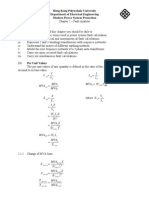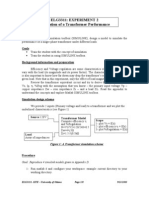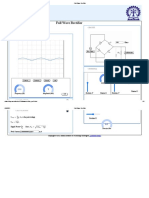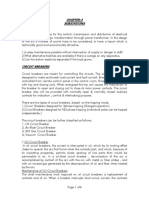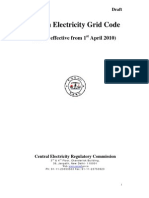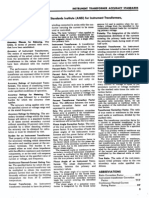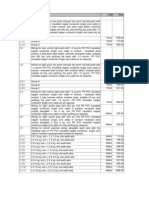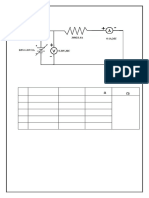FaultCal Adv
FaultCal Adv
Uploaded by
RK KCopyright:
Available Formats
FaultCal Adv
FaultCal Adv
Uploaded by
RK KOriginal Description:
Copyright
Available Formats
Share this document
Did you find this document useful?
Is this content inappropriate?
Copyright:
Available Formats
FaultCal Adv
FaultCal Adv
Uploaded by
RK KCopyright:
Available Formats
Modern Protection Methods - Lect 2 Fault Calculations 05/09/2005
Lecture 2
Fault Calculations
05/09/2005 Hong Kong Polytechnic University 1
Symmetrical and Unsymmetrical Fault
Calculations
Per unit representation
Symmetrical fault calculations
Sequence components
Connection of sequence networks under
various unsymmetrical fault conditions
Transformer zero sequence network
representation
Hong Kong Polytechnic University 05/09/2005 2
Hong Kong Polytechnic University 1
Modern Protection Methods - Lect 2 Fault Calculations 05/09/2005
Symmetrical Fault Analysis
Per Unit Values
The per unit values of any quantity is defined
as the ratio of the quantity expressed as a
decimal to its base value.
V I
V pu= I pu =
Vb Ib
MVA
MVA pu = MVA b = 3Vb ph I b ph
MVAb
Hong Kong Polytechnic University 05/09/2005 3
Z Vb
Z pu = where Z b =
Zb Ib
IbZ
=
Vb
3Vb I b Z MVA SC = 3Vb I f
=
3Vb2 MVAb
=
MVAb Z Z T pu
=
(Vb line )2
Hong Kong Polytechnic University 05/09/2005 4
Hong Kong Polytechnic University 2
Modern Protection Methods - Lect 2 Fault Calculations 05/09/2005
Change of MVA base
MVAb new Z
Z pu new =
(Vb line ) 2
MVAb old Z
Z pu old =
(Vb line ) 2
Z pu new MVAb new
=
Z pu old MVAb old
Hong Kong Polytechnic University 05/09/2005 5
Change of Voltage base
MVAb Z
Z pu new =
(Vb l new ) 2
MVAb Z
Z pu old =
(Vb l old ) 2
Z pu new (Vb l old ) 2
=
Z pu old (Vb l new ) 2
Hong Kong Polytechnic University 05/09/2005 6
Hong Kong Polytechnic University 3
Modern Protection Methods - Lect 2 Fault Calculations 05/09/2005
Change of both MVA base and Voltage
base
Z pu new MVAb new (Vb l old ) 2
=
Z pu old MVAb old (Vb l new ) 2
Hong Kong Polytechnic University 05/09/2005 7
Symmetrical Components
V a= Zs Ia + Zm Ib + Zm Ic
V b= Zm Ia + Zs Ib+ Zm Ic
V c= Zm Ia+ Zm Ib+ Zs Ic
[V ] = [Z ][I ]
⎡ ⎤ ⎡V a ⎤ ⎡ ⎤ ⎡I a⎤ ⎡ ⎤ ⎡ Z s Z m Z m⎤
⎢ ⎥ ⎢ ⎥ ⎢ ⎥ ⎢ ⎥ ⎢ ⎥ ⎢ ⎥
⎢V ⎥ = ⎢V b ⎥ ⎢ I ⎥ = ⎢ I b⎥ ⎢Z ⎥ = ⎢ Z m Z s Z m ⎥
⎢ ⎥ ⎢ ⎥ ⎢ ⎥ ⎢ ⎥ ⎢ ⎥ ⎢ ⎥
⎣ ⎦ ⎢⎣V c ⎥⎦ ⎣ ⎦ ⎢⎣ I c ⎥⎦ ⎣ ⎦ ⎢⎣ Z m Z m Z s ⎥⎦
Hong Kong Polytechnic University 05/09/2005 8
Hong Kong Polytechnic University 4
Modern Protection Methods - Lect 2 Fault Calculations 05/09/2005
⎡ ⎤ ⎡1 1 1⎤ ⎡1 1 1⎤
-1
⎡ ⎤
⎢ ⎥ ⎢ ⎥ ⎢ ⎥ 1⎢ ⎥
⎢ ⎥
A = ⎢1 a
2
a ⎥ ⎢ ⎥
A = ⎢ 1 a a
2
⎥
⎢ ⎥ ⎢ ⎥ ⎢ ⎥ 3 ⎢ ⎥
⎣ ⎦ ⎢⎣1 a a 2 ⎥⎦ ⎣ ⎦ ⎢⎣1 a 2 a ⎥⎦
a = 1∠120° 1+ a + a2 = 0
[V ] = [Z ][A][A]-1 [I ]
[A]−1 [V ] = [A]-1 [Z ][A]× [A]-1 [I ]
-1
⎡ ⎤ ⎡ ⎤ ⎡1 1 1⎤ ⎡V a ⎤ ⎡V o ⎤ ⎡ ⎤
⎢ ⎥ ⎢ ⎥ 1⎢ ⎥⎢ ⎥ ⎢ ⎥ ⎢ ⎥
⎢ A ⎥ ⎢V ⎥ = 3 ⎢1 a a ⎥ ⎢V b ⎥ = ⎢V 1⎥ = ⎢ V s ⎥
2
⎢ ⎥ ⎢ ⎥ ⎢ ⎥⎢ ⎥ ⎢ ⎥ ⎢ ⎥
⎣ ⎦ ⎣ ⎦ ⎣⎢1 a
2
a ⎥⎦ ⎢⎣V c ⎦⎥ ⎣⎢V 2 ⎦⎥ ⎣⎢ _ ⎦⎥
Hong Kong Polytechnic University 05/09/2005 9
V0 = 1 (Va + Vb + Vc )
3
(
V1 = 1 Va + aVb + a 2Vc
3
)
(
V2 = 1 Va + a 2Vb + aVc
3
)
-1
⎡ ⎤ ⎡ ⎤ ⎡1 1 1⎤ ⎡ I a ⎤ ⎡ I o ⎤ ⎡ ⎤
⎢ ⎥ ⎢ ⎥ 1⎢ ⎥⎢ ⎥ ⎢ ⎥ ⎢ ⎥
⎢ ⎥ ⎢ ⎥ 3
A I = ⎢ 1 a a
2
⎥ ⎢ I b ⎥ = ⎢ I 1⎥ = ⎢ Is ⎥
⎢ ⎥ ⎢ ⎥ ⎢ ⎥⎢ ⎥ ⎢ ⎥ ⎢ ⎥
⎣ ⎦ ⎣ ⎦ ⎣⎢1 a
2
a ⎦⎥ ⎣⎢ I c ⎦⎥ ⎣⎢ I 2 ⎦⎥ ⎣⎢ _ ⎦⎥
I 0 = 1 (I a + I b + I c )
3
I 1 = 1 (I a + aI b + a 2 I c )
3
I 2 = 1 (I a + a 2 I b + aI c )
3
Hong Kong Polytechnic University 05/09/2005 10
Hong Kong Polytechnic University 5
Modern Protection Methods - Lect 2 Fault Calculations 05/09/2005
[A]−1 [Z ][A] = [Z ]
⎡1 1 1⎤ ⎡ Z s Z m Z m ⎤ ⎡1 1 1⎤
1⎢ ⎥⎢ ⎥⎢ ⎥
⎢1 a a 2 ⎥ ⎢ Z m Z s Z m ⎥ ⎢1 a 2 a ⎥
3⎢ ⎥⎢ ⎥⎢ ⎥
⎢⎣1 a 2 a ⎥⎦ ⎢⎣ Z m Z m Z s ⎥⎦ ⎢⎣1 a a 2 ⎥⎦
⎡Z s + 2 Z m 0 0⎤ ⎡Z o 0 0⎤
⎢ ⎥ ⎢ ⎥
=⎢ 0 Zs - Zm 0⎥ = ⎢ 0 Z 1 0⎥
⎢ ⎥ ⎢ ⎥
⎣⎢ 0 0 Z s - Z m ⎦⎥ ⎣⎢ 0 0 Z 2 ⎦⎥
⎡V o ⎤ ⎡ Z o 0 0 ⎤ ⎡ I o ⎤
⎢ ⎥ ⎢ ⎥⎢ ⎥
⎢V 1⎥ = ⎢ 0 Z 1 0 ⎥ ⎢ I 1⎥
⎢ ⎥ ⎢ ⎥⎢ ⎥
⎢⎣V 2 ⎥⎦ ⎢⎣ 0 0 Z 2 ⎥⎦ ⎢⎣ I 2 ⎥⎦
Hong Kong Polytechnic University 05/09/2005 11
[ I ] = [ A ] [ Is ]
⎡ I a ⎤ ⎡1 1 1⎤ ⎡ I o ⎤
⎢ ⎥ ⎢ ⎥⎢ ⎥
⎢ I b⎥ ⎢ a
= 1 2
a ⎥ ⎢ I 1⎥
⎢ ⎥ ⎢ ⎥⎢ ⎥
⎣⎢ I c ⎦⎥ ⎣⎢1 a a ⎦⎥ ⎣⎢ I 2 ⎦⎥
2
⎡V a ⎤ ⎡1 1 1⎤ ⎡V o ⎤
⎢ ⎥ ⎢ ⎥⎢ ⎥
⎢V b ⎥ = ⎢1 a 2 a ⎥ ⎢V 1⎥
⎢ ⎥ ⎢ ⎥⎢ ⎥
⎣⎢V c ⎦⎥ ⎣⎢1 a a ⎦⎥ ⎣⎢V 2 ⎦⎥
2
Hong Kong Polytechnic University 05/09/2005 12
Hong Kong Polytechnic University 6
Modern Protection Methods - Lect 2 Fault Calculations 05/09/2005
Single phase to earth (L-E) fault
Ia
Ib
Ic
Hong Kong Polytechnic University 05/09/2005 13
Va = 0 ∴, V1 + V2 + V0 = 0
I a = I f = I1 + I 2 + I 0
Ib = Ic = 0
1
I1 = I 2 = I 0 = I f
3
The +ve, -ve, 0 sequence networks are
therefore connected in series
Hong Kong Polytechnic University 05/09/2005 14
Hong Kong Polytechnic University 7
Modern Protection Methods - Lect 2 Fault Calculations 05/09/2005
Z1T
+ve G E1
Z2T
-ve
Z0T
0
Hong Kong Polytechnic University 05/09/2005 15
Example 1 – For a L-E fault in the system
shown below, calculate
The fault current
The phase–earth voltage of all 3 phases at R
Z1=j0.1 pu
Z2=j0.15 pu
Z0=j0.2 pu
R
G •
Z1=Z2=j0.2 pu
E=1.0 pu
Z0=j0.4 pu
Hong Kong Polytechnic University 05/09/2005 16
Hong Kong Polytechnic University 8
Modern Protection Methods - Lect 2 Fault Calculations 05/09/2005
1 1
I1 = I 2 = I 0 = = = − j 0.8
Z 1T + Z 2T + Z 0T j1.25
I F = 3I 0 = − j 2.4
V1 = E − I 1 Z 1S = 1 − (− j 0.8)( j 0.1) = 0.92
V2 = − I 2 Z 2 S = −(− j 0.8)( j 0.15) = −0.12
V0 = − I 0 Z 0 S = −(− j 0.8)( j 0.2 ) = −0.16
V A = V1 + V2 + V0 = 0.64
V B = a 2V1 + aV2 + V0 = 0.92∠240° − 0.12∠120° − 0.16
= −0.56 − j 0.9007 = 1.06∠ − 122°
V B = aV1 + a 2V2 + V0 = 0.92∠120° − 0.12∠240° − 0.16
= −0.56 + j 0.9007 = 1.06∠122°
Hong Kong Polytechnic University 05/09/2005 17
Single phase to earth (L-E) fault with fault
resistance
Ia
Ib
Ic
Rf
Hong Kong Polytechnic University 05/09/2005 18
Hong Kong Polytechnic University 9
Modern Protection Methods - Lect 2 Fault Calculations 05/09/2005
Va = I f Zf ∴, V1 + V2 + V0 = I f R f
I a = I f = I1 + I 2 + I 0
Ib = Ic = 0
1
I1 = I 2 = I 0 = I f
3
V1 + V2 + V0 = 3I 0 R f
Hong Kong Polytechnic University 05/09/2005 19
Z1T
+ve G E1
-ve Z2T
Z0T
0
3Rf
Hong Kong Polytechnic University 05/09/2005 20
Hong Kong Polytechnic University 10
Modern Protection Methods - Lect 2 Fault Calculations 05/09/2005
Example 2 – Calculate
The value of the neutral earthing resistance in
pu to limit the magnitude of the fault current
of a L-E fault to 1.2 pu
Z1=j0.1 pu
Z2=j0.15 pu
Z0=j0.2 pu
R
G •
Z1=Z2=j0.2 pu
E=1.0 pu
Z0=j0.4 pu
Hong Kong Polytechnic University 05/09/2005 21
3 3
I F = 3I 0 = =
Z 1T + Z 2T + Z 0T + 3R N 3R N + j1.25
3
IF = = 1.2
3R N + j1.25
32
= 1.2 2
(3R N ) 2
+ 1.25 2
R N = 0.72
Hong Kong Polytechnic University 05/09/2005 22
Hong Kong Polytechnic University 11
Modern Protection Methods - Lect 2 Fault Calculations 05/09/2005
Phase to phase (L-L) fault
Ia
Ib
Ic
Hong Kong Polytechnic University 05/09/2005 23
Ia = 0 ∴, I b = − I c = I f
I1 + I 2 = 0
Vb = Vc = V f
V1 = V2
The +ve, and -ve sequence networks are
therefore connected in parallel
Hong Kong Polytechnic University 05/09/2005 24
Hong Kong Polytechnic University 12
Modern Protection Methods - Lect 2 Fault Calculations 05/09/2005
Z1T
+ve G E1
-ve Z2T
Z0T
0
Hong Kong Polytechnic University 05/09/2005 25
Example 3 – a B-C fault occurs in the
system below, calculate
The fault current
Z1=j0.1 pu
Z2=j0.15 pu
Z0=j0.2 pu
R
G •
Z1=Z2=j0.2 pu
E=1.0 pu
Z0=j0.4 pu
Hong Kong Polytechnic University 05/09/2005 26
Hong Kong Polytechnic University 13
Modern Protection Methods - Lect 2 Fault Calculations 05/09/2005
1 1
I1 = I 2 = = = − j1.538
Z1T + Z 2T j 0.65
I F = I B = a 2 I 1 + aI 2 = a 2 − a I 1( )
= j 3I 1 = 2.66∠180°
Hong Kong Polytechnic University 05/09/2005 27
Phase to phase to earth (L-L-E) fault
with fault resistance
Ia
Ib
Ic
Rf
Hong Kong Polytechnic University 05/09/2005 28
Hong Kong Polytechnic University 14
Modern Protection Methods - Lect 2 Fault Calculations 05/09/2005
Ia = 0 I1 + I 2 + I 0 = 0
I f = Ib + Ic I b + I c = 3I 0
Vb = Vc = I f R f
V1 =
1
3
( 1
3
)
V a + aV b + a 2 V c = (V a − V b )
1
3
( 1
3
)
V 2 = V a + a 2 V b + aV c = (V a − V b )
V 0 = (V a + V b + V c ) = (V a + 2V b )
1 1
3 3
= V1 + V b = V1 + 3 I 0 R f
V1 = V 2 = V 0 − 3 I 0 R f
Hong Kong Polytechnic University 05/09/2005 29
Z1T
+ve G E1
-ve Z2T
Z0T
0
3Rf
Hong Kong Polytechnic University 05/09/2005 30
Hong Kong Polytechnic University 15
Modern Protection Methods - Lect 2 Fault Calculations 05/09/2005
Effect of Fault Impedance
Assume pre-fault load current = 0
EA, EB are in phase and have same magnitude.
EA = EB = E
Hong Kong Polytechnic University 05/09/2005 31
Single phase to earth (L-E) fault with fault
resistance
I1’, I2’, I0’
Ia Ia ’
Ib
Ic
Rf
Hong Kong Polytechnic University 05/09/2005 32
Hong Kong Polytechnic University 16
Modern Protection Methods - Lect 2 Fault Calculations 05/09/2005
Z1T
+ve G E1
-ve Z2T
Z0T
0
3Rf
Hong Kong Polytechnic University 05/09/2005 33
I A = I 1' + I 2' + I 0' = C1 I 1 + C 2 I 2 + C 0 I 0
Z B1T
C1 =
Z A1T + Z B1T
where Z A1T = Z SA1 + Z LA1
Z B1T = Z SB1 + Z LB1
Normally the + ve and - ve sequence
networks are identical
∴, I A = 2C1 I 1 + C 0 I 0
Hong Kong Polytechnic University 05/09/2005 34
Hong Kong Polytechnic University 17
Modern Protection Methods - Lect 2 Fault Calculations 05/09/2005
V A1 = C1 I 1 Z LA1 + V1
V A 2 = C 2 I 2 Z LA 2 + V2 = C1 I 1 Z LA1 + V2
V A0 = C 0 I 0 Z LA0 + V0
V1 + V2 + V0 = 3I 0 R f
V A = 2C1 I 1 Z LA1 + C 0 I 0 Z LA0 + 3I 0 R f
Hong Kong Polytechnic University 05/09/2005 35
Transformer Sequence Impedance
+ve and –ve sequence impedance
Hong Kong Polytechnic University 05/09/2005 36
Hong Kong Polytechnic University 18
Modern Protection Methods - Lect 2 Fault Calculations 05/09/2005
Zero sequence impedance of a two
winding transformer
The exciting branch is now the exciting
impedance to zero sequence voltages or currents
which are identical in all three phases. The core
design of transformer will affect the zero
sequence impedance.
Account must be taken of the method of
interconnection of the windings and the presence
or absence of a neutral connection.
Hong Kong Polytechnic University 05/09/2005 37
Hong Kong Polytechnic University 05/09/2005 38
Hong Kong Polytechnic University 19
Modern Protection Methods - Lect 2 Fault Calculations 05/09/2005
Does a physical circuit exist by means of which
zero sequence currents can be passed into the
winding in question from the external circuit on
that side (i.e. is there a neutral point on the
transformer or elsewhere which is connected to
earth or to a neutral wire, possibly through an
impedance). If so, the link 'a' is closed; if not it is
left open. This is done for each side of the
transformer in turn.
Can zero sequence currents circulate in the
winding in question, without flowing in the
external circuit (i.e. does a delta connection
exist). If so, the appropriate link 'b' is closed.
Hong Kong Polytechnic University 05/09/2005 39
Hong Kong Polytechnic University 05/09/2005 40
Hong Kong Polytechnic University 20
Modern Protection Methods - Lect 2 Fault Calculations 05/09/2005
Hong Kong Polytechnic University 05/09/2005 41
Hong Kong Polytechnic University 05/09/2005 42
Hong Kong Polytechnic University 21
Modern Protection Methods - Lect 2 Fault Calculations 05/09/2005
Hong Kong Polytechnic University 05/09/2005 43
+ve and –ve sequence network of three
winding transformers
Hong Kong Polytechnic University 05/09/2005 44
Hong Kong Polytechnic University 22
Modern Protection Methods - Lect 2 Fault Calculations 05/09/2005
Zero sequence network of three winding
transformers
Hong Kong Polytechnic University 05/09/2005 45
Hong Kong Polytechnic University 05/09/2005 46
Hong Kong Polytechnic University 23
Modern Protection Methods - Lect 2 Fault Calculations 05/09/2005
Earthing Methods
Solidly earthed
Resistance earthed
Reactance earthed
Resonant or Peterson Coil earthed
Insulated earthed
Earthing transformer
Hong Kong Polytechnic University 05/09/2005 47
Solidly earthed
The zero sequence impedance is a minimum. The
earth fault current is highest. However, overvoltage
in unfaulted phases is a minimum. Earth fault
protection is simple as the fault current is usually
high. Overvoltage during earth faults is usually less
than 0.8 times phase to phase voltage.
Resistance earthed
Earthing the system by resistor reduces both the fault
current and transient overvoltages. However, high
value of earthing resistance will produce overvoltage
in unfaulted phases during earth faults approaching
to phase to phase voltage.
Hong Kong Polytechnic University 05/09/2005 48
Hong Kong Polytechnic University 24
Modern Protection Methods - Lect 2 Fault Calculations 05/09/2005
Reactance earthed
Reactors are usually smaller and less expensive than
resistors, it can reduce fault current but this is
associated with a increase in transient overvoltages
during earth faults. Transient overvoltages are a
maximum when the value of earthing reactance is
approximately one third of the value required for
resonant earthing. In order to reduce the transient
overvoltages to an admissible level the earthing
reactance has to be reduced so that the earth fault
current approaches that for a solidly earthed system.
Overvoltages during earth faults will be between 0.8
times and full phase to phase voltage.
Hong Kong Polytechnic University 05/09/2005 49
Resonant or Peterson Coil earthed
When the earthing reactance is equal to the
total system capacitive reactance to earth,
arcing earth faults will be self extinguishing.
The system capacitance must however
remain fairly constant, otherwise the
efficiency of this earthing method is greatly
diminished. The steady state voltages in the
sound phases during a phase to earth fault is
the full phase to phase voltage.
Hong Kong Polytechnic University 05/09/2005 50
Hong Kong Polytechnic University 25
Modern Protection Methods - Lect 2 Fault Calculations 05/09/2005
Insulated earthed
The earth fault current is capacitive and if
small may be self extinguished. Automatic
segregation of faulty zones is extremely
difficult. The system can be run with an
earth fault for long periods. Overvoltages
during earth faults may be greater than phase
to phase voltage. Arcing earth faults are very
likely and these can result in high transient
overvoltages.
Hong Kong Polytechnic University 05/09/2005 51
Earthing transformer
In some cases where the neutral of the power
transformer is not available, the system is earthed
via a earthing transformer of zig-zag type. A
minimum impedance is offered to the flow of zero
sequence currents. Under normal operating
conditions the currents flowing through the
windings are the magnetising currents of the
earthing transformer. The earthing transformer is
designed to carry the maximum fault current for 30
seconds.
Hong Kong Polytechnic University 05/09/2005 52
Hong Kong Polytechnic University 26
Modern Protection Methods - Lect 2 Fault Calculations 05/09/2005
Use of earthing transformer
Hong Kong Polytechnic University 05/09/2005 53
Variation of Healthy Phase Voltages -
Single Phase to Earth Fault
2
a + aK 2 + K 0
Vb = a 2V1 + aV2 + V0 = Eb − Ea
(1 + K 2 + K 0 )
a + a2 K2 + K0
Vc = aV1 + a V2 + V0 = Ec −
2
E
(1 + K 2 + K 0 ) a
K0 −1
Vb = Eb − E
(2 + K 0 ) a
K0 −1
Vc = E c − E
(2 + K 0 ) a
Hong Kong Polytechnic University 05/09/2005 54
Hong Kong Polytechnic University 27
Modern Protection Methods - Lect 2 Fault Calculations 05/09/2005
Effectively
earthed system
Non-effectively
earthed system
A-E Fault
Hong Kong Polytechnic University 05/09/2005 55
Phase to Phase to Earth Fault
3K 2 K 0
Va = Ea
(K 2 + K 0 + K 2 K 0 )
3K 0
= Ea if K 2 = 1
(1 + 2K 0 )
Hong Kong Polytechnic University 05/09/2005 56
Hong Kong Polytechnic University 28
Modern Protection Methods - Lect 2 Fault Calculations 05/09/2005
B-C-E Fault
Hong Kong Polytechnic University 05/09/2005 57
For solidly earthed system and with a earth fault close to
generation, K0 may be approaching to 0.5. In this case,
the voltage in the sound phase is below rated phase to
neutral voltage.
For solidly earthed system and with a earth fault more
distant from generation, K0 may be approaching to 1.0.
In this case, the voltage in the sound phase equals the
rated phase to neutral voltage.
Even on a solidly earthed system a earth fault far away
from the source of generation, can result in a value of K0
approaching to 2.5 to 4.5. The voltage in the sound phase
will increase above the normal rated phase to neutral
voltage.
Hong Kong Polytechnic University 05/09/2005 58
Hong Kong Polytechnic University 29
Modern Protection Methods - Lect 2 Fault Calculations 05/09/2005
What is effective earthed system?
During phase to earth faults, the voltage to
earth voltage of the sound phases does not
exceed 80 % of the voltage between lines
of the system.
Hong Kong Polytechnic University 05/09/2005 59
Effective earthing includes
Direct earthing
Low reactance earthing.
Non effective earthing is characterised
by a high Z0 / Z1 ratio (large K0) and
includes
Resistance earthing
Distribution transformer earthing
Resonant earthing
Insulated systems.
Hong Kong Polytechnic University 05/09/2005 60
Hong Kong Polytechnic University 30
Modern Protection Methods - Lect 2 Fault Calculations 05/09/2005
Neutral Displacement and Residual
Voltages
3V AN
VNG = − I F Z E = − ZE
Z1 (1 + K 2 + K 0 ) + 3Z E
ZE
=− V AN if K 2 = K 0 = 1
Z1 + Z E
Hong Kong Polytechnic University 05/09/2005 61
Hong Kong Polytechnic University 05/09/2005 62
Hong Kong Polytechnic University 31
Modern Protection Methods - Lect 2 Fault Calculations 05/09/2005
Residual voltage measurement can be used
to detect earth faults on a system and to
provide a polarising quantity for directional
earth fault relays.
The residual voltage Vres depends mainly
on the value of K0 and ZE.
On systems with high earthing impedance
or insulated neutral, the value of Vres will
approach 3 times rated phase to neutral
voltage.
Hong Kong Polytechnic University 05/09/2005 63
On solidly earthed systems the value of K0 may
be small and there may be insufficient neutral
displacement to provide the necessary polarising
quantities. For this reason, where directional earth
fault relays are used at generating stations where
the system is solidly earthed, current polarisation
is preferred to voltage polarisation.
As the voltage between the neutral of power
transformers and earth is small during earth faults
on solidly earthed systems, graded insulation can
be used with considerable reduction in cost.
Hong Kong Polytechnic University 05/09/2005 64
Hong Kong Polytechnic University 32
Modern Protection Methods - Lect 2 Fault Calculations 05/09/2005
Calculate the value of the neutral
earthing resistor to limit the earth fault
current to 2 times full load current of the
transformer and the voltage of unfaulted
phases
15 kV at the busbar.
125 MW
Z= j0.125 pu
Z1=j0.08pu
150 MVA
Z2=j0.12pu
15/132 kV
Z0=j0.2pu
132 kV
G
Z1=Z2= j5Ω
Z0= j10Ω
Hong Kong Polytechnic University 05/09/2005 65
3
=2
ZT1 + ZT 2 + Z T 0 + 3RN
3
=2
3RN + j 0.787
[(3R N ) 2 + 0.787 2 = 2.25 ]
RN = 0.4256 = 49.4Ω
Hong Kong Polytechnic University 05/09/2005 66
Hong Kong Polytechnic University 33
Modern Protection Methods - Lect 2 Fault Calculations 05/09/2005
1
I1 = I 2 = I 0 =
3 × 0.4256 + j 0.787
= 0.5675 − j 0.35 = 0.667∠ − 31.6°
V B / B1 = E − I 1 ( Z S 1 + Z Tx1 )
= 1 − (0.5675 − j 0.35)( j 0.221) = 0.923 − j 0.125
V B / B 2 = − I 2 ( Z S 2 + Z Tx 2 )
= −(0.5675 − j 0.35)( j 0.264) = −0.0923 − j 0.1498
VB / B0 = − I 0 ( Z Tx 0 + 3 R N )
= −(0.5675 − j 0.35)(1.277 + j 0.125) = −0.768 + j 0.376
Hong Kong Polytechnic University 05/09/2005 67
VB / B A = VB / B1 + VB / B 2 + VB / B 0
= 0.06 + j 0.1 = 9.1kV
VB / B B = a 2VB / B1 + aVB / B 2 + VB / B 0
= (−0.5 − j 0.866)(0.923 − j 0.125) +
(−0.5 + j 0.866)(−0.0923 − j 0.1498) + (−0.768 + j 0.376)
= −1.162 − j 0.366 = 1.22∠ − 162.5° = 93kV
VB / B C = aVB / B1 + a 2VB / B 2 + VB / B 0
= (−0.5 + j 0.866)(0.923 − j 0.125) +
(−0.5 − j 0.866)(−0.0923 − j 0.1498) + (−0.768 + j 0.376)
= −1.21 + j1.393 = 1.84∠131° = 140kV
Hong Kong Polytechnic University 05/09/2005 68
Hong Kong Polytechnic University 34
Modern Protection Methods - Lect 2 Fault Calculations 05/09/2005
Advance Fault Calculation
How a 3 phase auto transformer is
represented in unsymmetrical fault
calculation?
More unsymmetrical fault calculation
Open circuit fault
Simultaneous fault – OC and 1 Ph/E fault
simultaneously
Hong Kong Polytechnic University 05/09/2005 69
Sequence circuit of 3 phase auto transformer
Positive and negative sequence network of a 3 phase auto transformer
Zero sequence network of a 3 phase auto transformer
Hong Kong Polytechnic University 05/09/2005 70
Hong Kong Polytechnic University 35
Modern Protection Methods - Lect 2 Fault Calculations 05/09/2005
I L 0 n C = I H 0 (n S + n C )
With the tertiary winding open circuited
nC
I H 0= I L 0
n S + nC
1
= I L0
1+ N
nS
where N =
nC
EH n + nC
= S =1+ N
EL nC
⎡ 1 ⎤
I L 0 − I H 0 = I L 0 ⎢1 −
⎣ 1 + N ⎥⎦
N
= I L0
1+ N
Hong Kong Polytechnic University 05/09/2005 71
In the zero sequence network, Z X seems to be :
I L 0 Z X = I L 0 Z L + 3(I L 0 − I H 0 )Z n
N
= ZL + 3 Zn
1+ N
Similarly,on the HV side, Z Y' seems to be :
I H 0 Z Y = Z H − 3(I L 0 − I H 0 )Z n
I L0 I N
Z Y = L0 Z H − 3 I L0 Z n
1+ N 1+ N 1+ N
Z Y = Z H − 3NZ n referring to HV side
N
Z Y' = Z H' − 3Z n referring to LV side
(1 + N )2
Hong Kong Polytechnic University 05/09/2005 72
Hong Kong Polytechnic University 36
Modern Protection Methods - Lect 2 Fault Calculations 05/09/2005
Now consider the HV side open circuited but with the
tertiary winding closed
I T 0 (Z X + Z Z ) = I L 0 (Z L + Z T + 3 Z n )
Z X + Z Z = Z L + Z T + 3Z n by using p.u. values
N
As Z X = Z L + 3Z n
1+ N
1
∴, Z Z = Z T + 3Z n
1+ N
Hong Kong Polytechnic University 05/09/2005 73
Open circuit fault – open circuit of phase
conductor
E xa = E ya + I a Z a and E x0=
1
3
[
(E ya + I a Z a ) + E yb + E yc ]
E xb = E yb
[
= (E ya + E yb + E yc ) + I a Z a
1
3
]
E xc = E yc
1
E x0= E y0+ I a Z a
3
1
and similarly E x1 = E y1 + I a Z a
3
1
E x2= E y2+ I a Z a
3
Hong Kong Polytechnic University 05/09/2005 74
Hong Kong Polytechnic University 37
Modern Protection Methods - Lect 2 Fault Calculations 05/09/2005
IaZa = Za (I1 + I2 + I0 )
1 1
3 3
Hong Kong Polytechnic University 05/09/2005 75
Simultaneous fault –one phase open circuit
on one side and phase to earth fault on the
other side in the same phase
Ia P Q Ia ’
Ib I b’
Ic Ic’
G
Hong Kong Polytechnic University 05/09/2005 76
Hong Kong Polytechnic University 38
Modern Protection Methods - Lect 2 Fault Calculations 05/09/2005
Hong Kong Polytechnic University 05/09/2005 77
For the open circuit fault at P side,
I a= 0
∴, I a1= −( I a 2 + I a 0 )
V b−Vb' = 0
( ) ( ) (
∴, a 2 V a1−Va'1 + a V a 2−Va' 2 + V a 0−Va' 0 = 0 )
V c−Vc' = 0
( ) ( ) (
∴, a V a1−Va'1 + a 2 V a 2−Va' 2 + V a 0−Va' 0 = 0 )
For this to be true,
(V a1 ) (
−Va'1 = V a 2−Va' 2 = V a 0−Va' 0) ( )
Hong Kong Polytechnic University 05/09/2005 78
Hong Kong Polytechnic University 39
Modern Protection Methods - Lect 2 Fault Calculations 05/09/2005
For the 1 phase to earth fault at Q side,
Va' = 0
∴, Va'1 + Va' 2 + Va' 0 = 0
I b+ I b' = 0
( ) ( ) (
∴, a 2 I a1+ I a' 1 + a I a 2+ I a' 2 + I a 0+ I a' 0 = 0 )
I c+ I c' = 0
( ) ( ) (
∴, a I a1+ I a' 1 + a 2 I a 2+ I a' 2 + I a 0+ I a' 0 = 0 )
For this to be true,
(I ) ( ) (
+ I a' 1 = I a 2+ I a' 2 = I a 0+ I a' 0
a1 )
Hong Kong Polytechnic University 05/09/2005 79
Hong Kong Polytechnic University 05/09/2005 80
Hong Kong Polytechnic University 40
Modern Protection Methods - Lect 2 Fault Calculations 05/09/2005
Fault Transients in Power System
400 kV system, line length 125 km
Fault point is 100 km away from local end
Remote end source fault level 35 GVA
Local end source fault level changes from 35 GVA
(strong source) to 5 GVA (weak source)
Fault inception is at voltage zero to produce
maximum transient but has negligible offsets
Hong Kong Polytechnic University 05/09/2005 81
Strong source
Voltage and current at relaying point
Hong Kong Polytechnic University 05/09/2005 82
Hong Kong Polytechnic University 41
Modern Protection Methods - Lect 2 Fault Calculations 05/09/2005
Weak Source
Voltage and current at relaying point
Hong Kong Polytechnic University 05/09/2005 83
Further Study
Paul M. Anderson, “Analysis of Faulted
Power Systems”, IEEE Press, 1995.
Hong Kong Polytechnic University 05/09/2005 84
Hong Kong Polytechnic University 42
Modern Protection Methods - Lect 2 Fault Calculations 05/09/2005
Self Evaluation
Do you understand the physical meaning of positive
and negative sequence components?
What is the relationship between mutual coupling
impedance and sequence impedance in the power
system?
How do you transform between the actual system
voltages and currents into their corresponding sequence
components?
Do you understand why the actual system network can
be transformed into sequence networks?
How the sequence networks are connected under
various unsymmetrical faults?
Hong Kong Polytechnic University 05/09/2005 85
Self Evaluation
Do you know how to form the zero sequence network
of a power transformer? Now do you understand how to
form the zero sequence network of the power system?
Do you know how to solve tutorial questions from 1 to
10?
How do you connect the sequence networks for an open
circuited fault?
How to represent the simultaneous fault by sequence
networks?
Are you able to solve the open circuit and simultaneous
fault problems from Q11 to Q15?
Hong Kong Polytechnic University 05/09/2005 86
Hong Kong Polytechnic University 43
You might also like
- EE 215 Lab 3 HandoutDocument5 pagesEE 215 Lab 3 HandoutArnav Mathur100% (1)
- EE2351-Power System Analysis PDFDocument15 pagesEE2351-Power System Analysis PDFRK K0% (1)
- Knee Point Voltage CalculationDocument1 pageKnee Point Voltage CalculationRK K75% (4)
- Marshall JTM 45/100 Hendrix ManualDocument5 pagesMarshall JTM 45/100 Hendrix Manualtsj9205No ratings yet
- Modern Power System Fault CalculationDocument34 pagesModern Power System Fault Calculationjaved shaikh chaand100% (2)
- Ohms Method: Per-Unit SystemDocument4 pagesOhms Method: Per-Unit SystemengrrajuNo ratings yet
- Lecture 5. Silicon Controlled Rectifiers Part 2Document4 pagesLecture 5. Silicon Controlled Rectifiers Part 2Hassan FarssiNo ratings yet
- SEE716 - Seminar2 - PerUnit Method of CalculationsDocument18 pagesSEE716 - Seminar2 - PerUnit Method of CalculationsAnuNo ratings yet
- 6th Sem Power SystemDocument170 pages6th Sem Power SystemHarishNo ratings yet
- 02 Analysis of Faults Notes PDFDocument38 pages02 Analysis of Faults Notes PDFJi Chou ChenNo ratings yet
- Chapter 4+6Document25 pagesChapter 4+6louischen1228No ratings yet
- Per UnitDocument16 pagesPer UnitTrishitNo ratings yet
- 03 - Loadflow - PanelDocument94 pages03 - Loadflow - PaneledwardoNo ratings yet
- 5 Overview PsasDocument19 pages5 Overview Psasعلي صالحNo ratings yet
- Power System Modeling and AnalysisDocument79 pagesPower System Modeling and AnalysisjjhenNo ratings yet
- CP1 Short Circuit Analysis Part2 Version2Document96 pagesCP1 Short Circuit Analysis Part2 Version2jjhenNo ratings yet
- Power System Protection LabDocument30 pagesPower System Protection LabKartik SharmaNo ratings yet
- Elg3311: Experiment 2 Simulation of A Transformer PerformanceDocument8 pagesElg3311: Experiment 2 Simulation of A Transformer Performancesharif114100% (2)
- Ch2 Electric PotentialDocument46 pagesCh2 Electric Potentialshahrul0% (1)
- EE1352 Power System AnalysisDocument84 pagesEE1352 Power System AnalysisAnonymous N579LQLdNo ratings yet
- Etap Load Flow 1716569946Document75 pagesEtap Load Flow 1716569946bimakerja18No ratings yet
- EE2351 UwDocument87 pagesEE2351 UwShafayet UddinNo ratings yet
- Perf 21-22 SH Class1 SecBDocument10 pagesPerf 21-22 SH Class1 SecBdark gamerNo ratings yet
- Zero Sequence Impedence DeterminationDocument81 pagesZero Sequence Impedence DeterminationSanthosh OsNo ratings yet
- PSA NotesDocument87 pagesPSA Notess.chellamNo ratings yet
- Lecture08 MicroelectronicDocument7 pagesLecture08 MicroelectronicGaith Al EliwiNo ratings yet
- EL103 Experiment-5 Superposition PrincipleDocument1 pageEL103 Experiment-5 Superposition Principlemarshalbaba396No ratings yet
- Analysis of Fault Location AlgorithmsDocument6 pagesAnalysis of Fault Location Algorithmseallam70No ratings yet
- Eee 415!2!3 PhbalancedcircuitsDocument38 pagesEee 415!2!3 PhbalancedcircuitsimperiumcopyNo ratings yet
- AC PowerDocument14 pagesAC PowermoatlhodiNo ratings yet
- SD Mos 2Document109 pagesSD Mos 2sanjeevkumarsudhanshu345No ratings yet
- Per-Unit System: EE341 - Energy Conversion Ali Keyhani Transformer Lecture #3Document32 pagesPer-Unit System: EE341 - Energy Conversion Ali Keyhani Transformer Lecture #3always_lucky_one100% (1)
- Per Unit System Explanation With Solved ExampleDocument13 pagesPer Unit System Explanation With Solved ExampleMoudinet Passoret100% (1)
- Loadflow PanelDocument94 pagesLoadflow PanelDesi HertianiNo ratings yet
- Prof. Dr. Magdi El-Saadawi: Web Site: E-MailDocument27 pagesProf. Dr. Magdi El-Saadawi: Web Site: E-MailMagdi SaadawiNo ratings yet
- Per Unit System: Prof. M Venkateswara RaoDocument12 pagesPer Unit System: Prof. M Venkateswara RaoAnkunjNo ratings yet
- All Chapter Download Electric Circuits 10th Edition Nilsson Solutions ManualDocument68 pagesAll Chapter Download Electric Circuits 10th Edition Nilsson Solutions Manualrasmuzakturk100% (1)
- Electrical Power Systems D Das Ch5Document17 pagesElectrical Power Systems D Das Ch5Engr.Arslan AbbasNo ratings yet
- 3_phase_and_sym_compDocument68 pages3_phase_and_sym_compvishwa rajendraNo ratings yet
- PSA QBDocument79 pagesPSA QBbambam91037No ratings yet
- Lecture5 2MM3Document8 pagesLecture5 2MM3walterfromtektipNo ratings yet
- EE204 Lecture Notes Lecture 02Document7 pagesEE204 Lecture Notes Lecture 02Haimanot DubaleNo ratings yet
- 2365 02 l2 202 Handout 2Document5 pages2365 02 l2 202 Handout 2dvm4yfptzmNo ratings yet
- Pu System - 2Document1 pagePu System - 2Hnoon MtfahemNo ratings yet
- Polyphase SystemsDocument58 pagesPolyphase Systemssaleh gaziNo ratings yet
- Lecture Note Part 34Document11 pagesLecture Note Part 34happyphon666No ratings yet
- Lecture Note Part 34 - 241110 - 164618Document11 pagesLecture Note Part 34 - 241110 - 164618usaikomaNo ratings yet
- Fundamental Principles and Methods in Power System AnalysisDocument253 pagesFundamental Principles and Methods in Power System AnalysisJohn Lloyd SantosNo ratings yet
- 3 Laws of Motion and FrictionDocument97 pages3 Laws of Motion and FrictionshravanthsennimalaiNo ratings yet
- F HG I KJ: 1.5 The Per Unit SystemDocument1 pageF HG I KJ: 1.5 The Per Unit SystemragupaNo ratings yet
- BASIC ELECTRICAL ENGINEERING Module 2Document40 pagesBASIC ELECTRICAL ENGINEERING Module 2cinema masterNo ratings yet
- Chapter 8 Symmetrical FaultDocument42 pagesChapter 8 Symmetrical FaultNompumelelo GabaNo ratings yet
- PSP2020-Lect File 3Document34 pagesPSP2020-Lect File 3Anas AhmedNo ratings yet
- Lecture3Document9 pagesLecture3deepanryanNo ratings yet
- Full-Wave RectifierDocument2 pagesFull-Wave Rectifier2K20CEEE23 Nishi Kant KumarNo ratings yet
- PSA ManualsDocument53 pagesPSA ManualsEngr Khizer HayatNo ratings yet
- Ch03 - Resistive CircuitsDocument11 pagesCh03 - Resistive CircuitsThadnyiang ThaddeusNo ratings yet
- Data Sheet: BZV55 SeriesDocument12 pagesData Sheet: BZV55 Seriesdrain rainNo ratings yet
- Beles1 701Document2 pagesBeles1 701Arsh DeepNo ratings yet
- Load Flow Analysis: ETAP Workshop Notes © 1996-2009 Operation Technology, IncDocument75 pagesLoad Flow Analysis: ETAP Workshop Notes © 1996-2009 Operation Technology, Incjohan0818No ratings yet
- Power System AnalysisDocument25 pagesPower System AnalysisZuhaili Zawawi100% (1)
- Switched Capacitor ConverterDocument65 pagesSwitched Capacitor Convertersang young soNo ratings yet
- 8 Health Secrets From Ancient IndiaDocument2 pages8 Health Secrets From Ancient IndiaRK KNo ratings yet
- (Cafe) Protection and ControlDocument28 pages(Cafe) Protection and ControlRK KNo ratings yet
- Eee-Vi-Switchgear & Protection (10ee62) - Notes PDFDocument92 pagesEee-Vi-Switchgear & Protection (10ee62) - Notes PDFRK KNo ratings yet
- 32 184self Buildprocedure PDFDocument71 pages32 184self Buildprocedure PDFnitinatpNo ratings yet
- 670 Series ANSI: Engineering ManualDocument114 pages670 Series ANSI: Engineering ManualRK KNo ratings yet
- LI BB Sensitivity & Satability Test Report Rev NEW FORMDocument5 pagesLI BB Sensitivity & Satability Test Report Rev NEW FORMRK KNo ratings yet
- Bep 2Document4 pagesBep 2RK KNo ratings yet
- Eet 308 SP2 V2Document14 pagesEet 308 SP2 V2RK KNo ratings yet
- Eee-Vii-Computer Techniques Inâ Power Systemâ Â Analysis (06ee71) - Notes PDFDocument151 pagesEee-Vii-Computer Techniques Inâ Power Systemâ Â Analysis (06ee71) - Notes PDFRK KNo ratings yet
- A - MEDIA TO GET - ALL DATAS IN ELECTRICAL SCIENCE... !! - Transformer Stability Test Procedure PDFDocument1 pageA - MEDIA TO GET - ALL DATAS IN ELECTRICAL SCIENCE... !! - Transformer Stability Test Procedure PDFRK KNo ratings yet
- Communication System in Power SectorDocument100 pagesCommunication System in Power SectorRK K100% (2)
- Transient Performance of CVTsDocument3 pagesTransient Performance of CVTsajaysitaula8478No ratings yet
- Testing Proc of PTDocument11 pagesTesting Proc of PTRK KNo ratings yet
- IEGC Review ProposalDocument73 pagesIEGC Review ProposaldeepaknitkNo ratings yet
- CT-PT Accuracy StandardDocument6 pagesCT-PT Accuracy StandardEngr Irfan AkhtarNo ratings yet
- APTRANSCO Technical Reference Book 2011 Vol IDocument327 pagesAPTRANSCO Technical Reference Book 2011 Vol IAshok Kumar Krishnamurthy100% (4)
- Training Final ReportDocument45 pagesTraining Final ReportRK K100% (1)
- Alternating Current FundamentalsDocument154 pagesAlternating Current FundamentalsRK KNo ratings yet
- IEGC Review ProposalDocument73 pagesIEGC Review ProposaldeepaknitkNo ratings yet
- 11kv Megwin KioskDocument13 pages11kv Megwin KioskRK KNo ratings yet
- Rule 48 Precautions Against Leakage Before ConnectionDocument23 pagesRule 48 Precautions Against Leakage Before ConnectionRK KNo ratings yet
- Manual On TransformersDocument595 pagesManual On TransformersRK K100% (4)
- GW Galaxy Series Instruction Manual-EnDocument23 pagesGW Galaxy Series Instruction Manual-EnEe Qing KhooNo ratings yet
- Pioneer vsx-415k vsx-415sDocument76 pagesPioneer vsx-415k vsx-415selekossNo ratings yet
- tlv271 q1Document31 pagestlv271 q1Matias GonzalezNo ratings yet
- 1-2 Introduction To Control PDFDocument10 pages1-2 Introduction To Control PDFyapacagınız sıteyı s..100% (1)
- Micromaster 430: InverterDocument24 pagesMicromaster 430: InverterAmir SayahanNo ratings yet
- Magnetic Linear Encoder Systems BML: ... Non-Contacting and High-ResolutionDocument28 pagesMagnetic Linear Encoder Systems BML: ... Non-Contacting and High-ResolutionCsaba VargaNo ratings yet
- 520l0344 PVG32 Proportional Valves, Technical InformationDocument80 pages520l0344 PVG32 Proportional Valves, Technical Informationscalpin100% (1)
- Document Polarisation of LightDocument9 pagesDocument Polarisation of LightKunal KashyapNo ratings yet
- Plane-Parallel Resonator Configuration For High-NA EUV LithographyDocument18 pagesPlane-Parallel Resonator Configuration For High-NA EUV LithographyGary Ryan DonovanNo ratings yet
- IEC Numeros Normas NuevosDocument9 pagesIEC Numeros Normas NuevoszerferuzNo ratings yet
- B4304Document9 pagesB4304jamesearl_cubillasNo ratings yet
- FC302 Design GuideDocument280 pagesFC302 Design Guidedpack4798100% (1)
- High Speed RoutingDocument18 pagesHigh Speed RoutingbfNo ratings yet
- Components For Low Voltage Panel Boards TeknomegaDocument100 pagesComponents For Low Voltage Panel Boards TeknomegaMatheus AndreoNo ratings yet
- DSR Electrical 2012Document60 pagesDSR Electrical 2012vijay_raina31140% (1)
- Manual Tecnico Alarma BoschDocument78 pagesManual Tecnico Alarma BoschFelizardo Favela CamachoNo ratings yet
- Alinco DR 605T Service ID5833Document59 pagesAlinco DR 605T Service ID5833Pedro Paulo MelosNo ratings yet
- SUN ReportDocument10 pagesSUN Reportpratham sutharNo ratings yet
- 7SJ55x CatalogueDocument12 pages7SJ55x CataloguekhalidNo ratings yet
- Generator Excitation Control Systems & Methods - EBS, PMG, & AUXDocument5 pagesGenerator Excitation Control Systems & Methods - EBS, PMG, & AUXkechaouahmed81No ratings yet
- DOL StarterDocument4 pagesDOL Starterdramsree1No ratings yet
- LS4 Circuit Breaker Control: ManualDocument92 pagesLS4 Circuit Breaker Control: ManualMenno AkkermanNo ratings yet
- Advance Optima: Module Uras 14Document85 pagesAdvance Optima: Module Uras 14Hammad AshrafNo ratings yet
- BEEE ManualDocument29 pagesBEEE Manualtejapyla036No ratings yet
- Sku Sua5000rmi5uDocument3 pagesSku Sua5000rmi5uBawuk SukesiNo ratings yet
- Improvement in Power Quality of Grid Connected PV & Wind Power Generation SystemDocument9 pagesImprovement in Power Quality of Grid Connected PV & Wind Power Generation SystemIJRASETPublicationsNo ratings yet
- True RMS Voltmeter: Instruction ManualDocument124 pagesTrue RMS Voltmeter: Instruction ManualRafa DuverheisenNo ratings yet
- Exp 3Document8 pagesExp 3MANISHANo ratings yet




